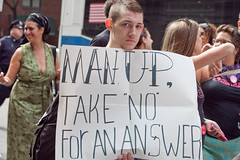Charlotte Allen Suggests Last-Minute Halloween Costume Idea: Misogynist Concern Troll

Unaccountably, the Washington Post The LA Times gave Charlotte Allen space to insinuate that skimpy Halloween costumes cause rape. Allen, a contributing editor at a conservative website called “Minding the Campus” is deeply concerned that the feminist anti-rape activists of SlutWalk and the Halloween-industrial-complex are accessories to sexual assault:
The other reality that feminists tend to deny is that rape and sexual desire are linked. Rape, in that view, is a purely political act of male dominance. This ignores the fact that the vast majority of rape victims are under age 30 — that is, when women are at their peak of desirability.
Rape is a criminal act, and it is a crime most men won’t commit regardless of how short a girl’s skirt is or how lovely her legs. But the fact that rapists tend to target young women rather than grandmotherly types suggests that in the real rape culture (in contrast to the imaginary rape culture of some feminist ideology), the faux-hos of Halloween and their SlutWalker counterparts marching in their underwear — like a man walking at night with a bulging wallet — should be careful about where they flash their treasure.
The relevant question is not whether rapists desire their victims. No doubt many do. It would be surprising to learn otherwise, given that so many rapists are dating, or married to, their victims.
The question is whether a sexy Halloween costume increases a woman’s risk of rape. Allen thinks it does, but offers no evidence to support her thesis. You’d think that would be fatal to an op/ed blaming rape on “sexy witch,” “sexy nurse,” and Lady Gaga costumes, but Allen is determined to make up in handwaving what she lacks in data.
Her conjecture is that women under 30 get raped more often because they’re the sexiest women, and therefore, anything a woman does to look even sexier increases her risk of rape.
This hypothesis is rooted in the inaccurate stereotype that rape is an uncontrollable frenzy of lust that women provoke in men. That’s like imagining all theft as an uncontrolled frenzy of consumerism. Nobody doubts that thieves want what they steal, but we don’t assume that the sheer desirability of an unguarded car stereo pushes them over the edge.
But the fact that most rape victims under 30 tells us little about the motives of rapists. As feminist blogger and practicing attorney Jill Filipovic notes, most victims of non-sexual assault are also under 30:
But, funny thing: Younger people are also the most likely group to be the victims of aggravated, non-sexual assault (just so we’re all on the same page here, the term “aggravated assault” means “the crime of physically attacking another person which results in serious bodily harm and/or is made with a deadly or dangerous weapon such as a gun, knife, sword, ax or blunt instrument”). In fact, younger people are victimized by violent crime more often than older folks as a general rule. A person between the ages of 12 and 24 is six times more likely to be the victim of a robbery than a person over the age of 50; about half of people who report being the victims of aggravated assault are under the age of 25. Men are much more likely than women to be the victims of violent crime. In every age group, black people are the most likely to be the victims of violent crime.
So yes, it is true that younger women are more likely to be targeted for sexual assault than older women. But it’s not because of The Sexy — unless hormones and hard-ons are what are causing criminals to choose their (mostly male) targets for robbery and assault also.
It is disappointing that the Post Times gave Allen a platform for victim-blaming, and sloppily argued victim-blaming at that.
[Photo credit: Lindsay Beyerstein, all rights reserved.]









